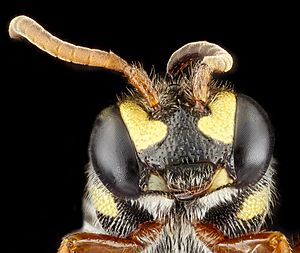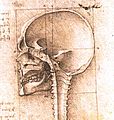Head facts for kids
The head is the part of the body where the brain is. It is also where the face is. Different things may be worn on the head, for example a headband, a headdress, or a hat.
Some people get pains in their head occasionally, known as headaches. Also, some people have worse pains in their head called migraines.
A head in English can also mean a person in charge of something, such as the head of a company.
Also, the word head can also mean the front of something. An example of this is the word "Headline", meaning large words on the front page of a newspaper.
Human head
The human head is an anatomical unit that consists of the skull, hyoid bone and cervical vertebrae. The term "skull" collectively denotes the mandible (lower jaw bone) and the cranium (upper portion of the skull that houses the brain). The skull can also be described as being composed of the cranium, which encloses the cranial cavity, and the facial skeleton (includes the mandible). There are eight bones in the cranium and fourteen in the facial skeleton.
Sculptures of human heads are generally based on a skeletal structure that consists of a cranium, jawbone, and cheekbone. Though the number of muscles making up the face is generally consistent between sculptures, the shape of the muscles varies widely based on the function, development, and expressions reflected on the faces of the subjects.
-
Mid-sagittal section of a human skull, by Leonardo da Vinci, c. 1489
Other animals
The evolution of a head is associated with the cephalization that occurred in Bilateria some 555 million years ago.
Arthropods
In some arthropods, especially trilobites (pictured at right), the cephalon, or cephalic region, is the region of the head which is a collective of "fused segments".
Insects

A typical insect head is composed of eyes, antennae, and components of mouth. As these components differ substantially from insect to insect, they form important identification links. Eyes in the head found, in several types of insects, are in the form of a pair of compound eyes with multiple faces. In many other types of insects the compound eyes are seen in a "single facet or group of single facets". In some case, the eyes may be seen as marks on the dorsal or located near or toward the head, two or three ocelli (single faceted organs).
Antennae on the insect's head is found in the form of segmented attachments, in pairs, that are usually located between the eyes. These are in varying shapes and sizes, in the form of filaments or in different enlarged or clubbed form.
Insects have mouth parts in various shapes depending on their feeding habits. Labrum is the "upper lip" which is in the front area of the head and is the most exterior part. A pair of mandible is found on backside of the labrum flanking the side of the mouth, succeeded by a pair of maxillae each of which is known as maxilliary palp. At the back side of the mouth is the labium or lower lip. There is also an extra mouth part in some insects which is termed as hypopharynx which is usually located between the maxillac.
Images for kids
-
The head of a death mask
-
Nerves of the human head, from Gray's Anatomy, 1858
-
Patron saints of Zürich, fresco, c. 1400–1425
See also
 In Spanish: Cabeza para niños
In Spanish: Cabeza para niños






